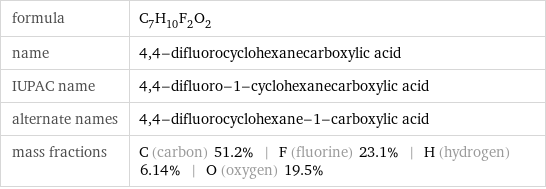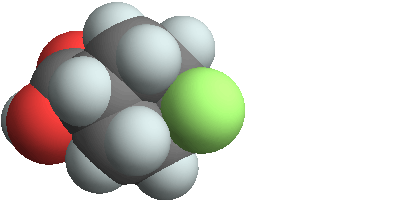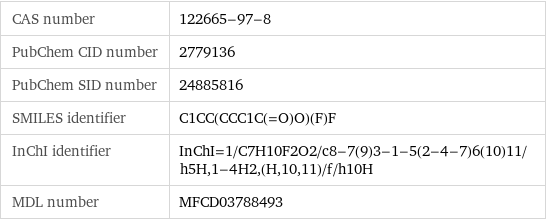Input interpretation

4, 4-difluorocyclohexanecarboxylic acid
Chemical names and formulas

formula | C_7H_10F_2O_2 name | 4, 4-difluorocyclohexanecarboxylic acid IUPAC name | 4, 4-difluoro-1-cyclohexanecarboxylic acid alternate names | 4, 4-difluorocyclohexane-1-carboxylic acid mass fractions | C (carbon) 51.2% | F (fluorine) 23.1% | H (hydrogen) 6.14% | O (oxygen) 19.5%
Lewis structure

Draw the Lewis structure of 4, 4-difluorocyclohexanecarboxylic acid. Start by drawing the overall structure of the molecule, ignoring potential double and triple bonds: Count the total valence electrons of the carbon (n_C, val = 4), fluorine (n_F, val = 7), hydrogen (n_H, val = 1), and oxygen (n_O, val = 6) atoms: 7 n_C, val + 2 n_F, val + 10 n_H, val + 2 n_O, val = 64 Calculate the number of electrons needed to completely fill the valence shells for carbon (n_C, full = 8), fluorine (n_F, full = 8), hydrogen (n_H, full = 2), and oxygen (n_O, full = 8): 7 n_C, full + 2 n_F, full + 10 n_H, full + 2 n_O, full = 108 Subtracting these two numbers shows that 108 - 64 = 44 bonding electrons are needed. Each bond has two electrons, so in addition to the 21 bonds already present in the diagram add 1 bond. To minimize formal charge oxygen wants 2 bonds and carbon wants 4 bonds. Identify the atoms that want additional bonds and the number of electrons remaining on each atom: Fill in the 1 bond by pairing electrons between adjacent highlighted atoms: Answer: | |
3D structure

3D structure
Basic properties

molar mass | 164.15 g/mol phase | solid (at STP) melting point | 105 °C
Units

Chemical identifiers

CAS number | 122665-97-8 PubChem CID number | 2779136 PubChem SID number | 24885816 SMILES identifier | C1CC(CCC1C(=O)O)(F)F InChI identifier | InChI=1/C7H10F2O2/c8-7(9)3-1-5(2-4-7)6(10)11/h5H, 1-4H2, (H, 10, 11)/f/h10H MDL number | MFCD03788493